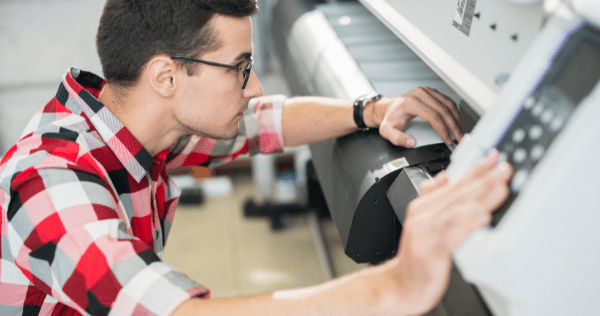As a sign and print industry professional, you probably have a little idea about dye sublimation or heat transfer printing.
Yes, digital printing technology involves a heat transfer process for printing designs and images on solid objects.
Most dye-sublimation printers work with transfer papers. These devices are specifically designed for dye-sub application and work with dedicated dispersible dyes.
First, the printer imprints dye-sub inks on the transfer paper, fabric, or selected material. Then, the fabric is placed on the object to be printed, and heat pressed.
The extreme temperature turns the ink on the transfer paper into heated gas. And this helps in printing perfectly on solid objects.
Advantages
Accomplishing the magic of printing on various materials was never so easy. The high-end technology uses heat and pressure for printing, ensuring you get vibrant and bright graphics.
Printing on t-shirts was a fairly labor-intensive process before the introduction of digital printing. But not anymore. Dye sublimation printers work with CMYO dye cartridges. And these dyes make the technique perfect for fabrics. The design becomes a part of the fabric rather than just covering it. Also, as sublimation printing is permanent, you won’t have to worry about design parts flaking off.
Setting up production in the quickest time possible has become easier with dye sublimation printing. Due to such production flexibility, companies use it to mass-produce a wide range of products.
Dye sublimation printing helps produce visually appealing and durable products compared to other printing techniques. You can print even full-colored images on hard surfaces.
Overall, promotional items for sports teams, charities, schools, and small businesses, can be manufactured in bulk quantities.
Industries That Have Benefited From Dye Sublimation Printing
As you can guess, the printing method is not meant for printing on envelopes, labels, or papers.
Dye sublimation has helped several businesses in sports apparel, soft signage, and home decor to ensure they get the best out of the steady growth the industry is witnessing.
Heat transfer printing is ideal for fabric banners. But, most importantly, it remains the first choice for printing on garments made from polyester or man-made materials.
Besides sports apparel, dye sublimation is used to print on bathing suits, curtains, floor mats, wristbands, mouse pads, and athletic apparel.
You can print on literally anything made from plastic, fiber, acrylic, metal, glass, ceramic, synthetic, and rubber.
Some of the Most Appreciated Dye Sublimation Printing Devices
You certainly wish to know about dye sublimation printers and brands considered best by our experts. From impressive factory production to the occasional use, devices are available for every job.
- If you want a giant to indulge in high production, the 74” wide Mimaki TS55 is your machine.
- Mimaki CJV300-160 Plus is ideal for printing coffee mugs and other small items. It creates magic by combining contour cutting with high-quality, dye-sub graphics.
- When it comes to apparel and trade show materials, you can create wonders with Mutoh’s 64” model Mutoh VJ-1638WX.
- If you are looking for a four-color printer suitable for printing flags and apparel, try the 42” Mutoh RJ-900X-U1.
- Epson F6370H is another superb 44” device that can contribute towards improving productivity.
Simply put, there are a variety of devices in various price segments.
Time to Know More
The technique is not ideal for garments made from natural fabrics, including cotton. Further, the printing process is slightly different for sportswear, hosiery, kitchenware, etc.
No worries, allow us to train you. You can always connect with our specialists for questions on dye sublimation printing.
We at Adendo can provide onsite or online, individualized or group-based training sessions on the sign and print industry concepts. Entrepreneurs, professionals, and corporations trust our team for subject matter training.



